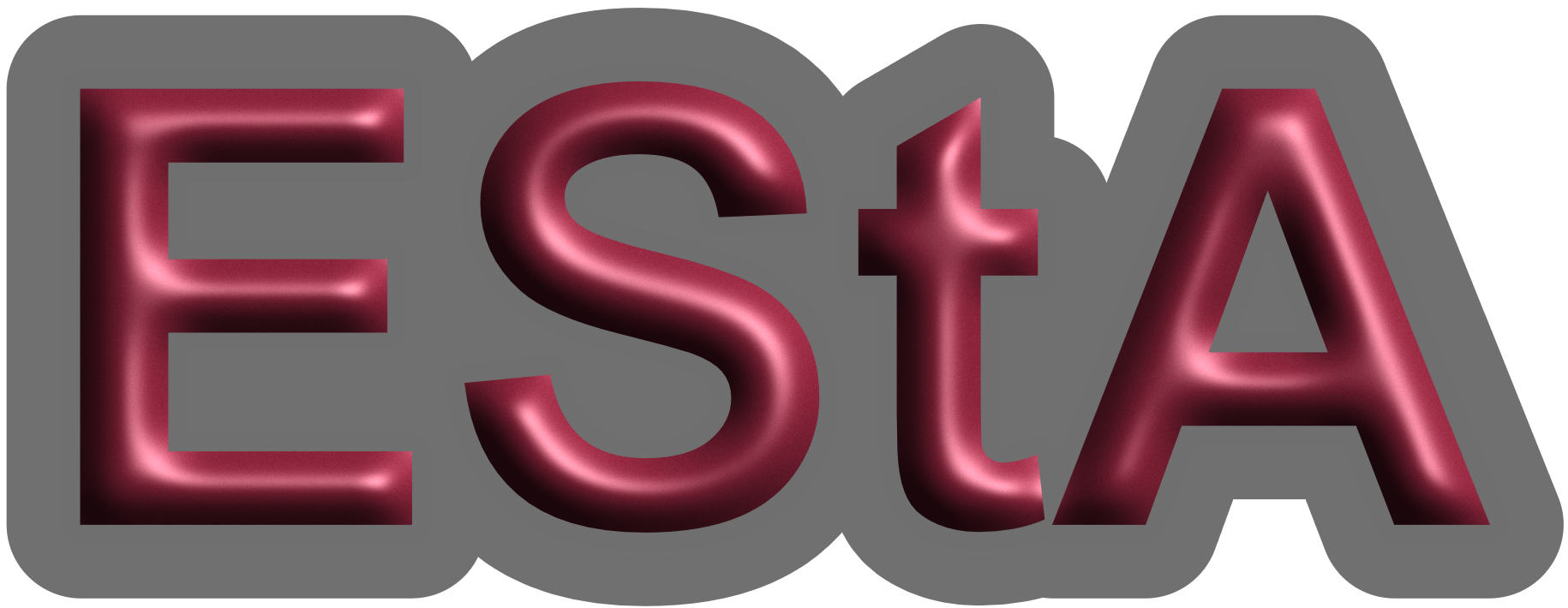Features
Contents

Electronic Structure Automater (EStA) aka pytware for analyzing and calculating to some extent the electronic structure of materials and molecules.
EStA software package is capable of analyzing, pre-processing, and post-processing data from different software packages such as vasp, quantum-espresso, gaussian, GRRM, xTB, and so on. It can automatically generate input files for vasp, quantum-esspresso, GRRM, gaussian and other codes as well can do some model calculations. It is written in python3, modern Fotran, and some part in C. In future, it will be able to perform calculations for predicting electronic and transport properties.
Features#
automatic input generations for different electronic structure softwares
output analysis of different file formats such xml, yaml, json, and so on
vibrational and thermodynamical analysis of atomic and molecular systems
transition state finding using CI-NEB approach (interfaced with quantum-espresso for the time being!!)
zone centre phonon calculations based on gradient input as implemented in phonon directory (to be expanded to whole zone)
model calculations of lattice thermal conductivity (first principles calculation is experimental)
tight binding calculation of bulk materials
point group detection (space group detection and other stuff carried out using spglib)
lattice transformation analysis
machine learning prediction of important physical property (more to add soon!!)
easy to use unit conversion routine; axsf, bxsf, cube files .. for visualizations etc
reading force constants from phonopy calculations at gamma or any other q-point and finding the force-constants ( \(\phi_{i,j})\) between all pair of atoms or specific atom pairs along with respective distances; further exploration of stretching and bending force constants (\(\phi_{stretch}\) and \(\phi_{bend}\))
Infra-red and Raman-intensity calculations for periodic systems (automatically generates the needed files to compute the \(\epsilon_{\infty}\))
Manipulation of atomic and crystal structures such as atomic substitution, deletion, extension, modulation, and inversion, etc.
more routines (interfacing of xTB with GRRM, minimization procedures, fortran code for calculating static dielectric constant, mode oscillator strength etc..) are there, but to be added to esta package!!!
Author’s research areas#
thermoelectrics, heterogeneous catalysis, homogeneous catalysis, defects, phonons, and machine learning
EStA:
PACKAGES:
- esta.general package
- Submodules
- esta.general.aadhaar module
- esta.general.add_const_to_dict module
- esta.general.add_vacuum_to_unit_cell module
- esta.general.affine module
- esta.general.atomic_Distance_Density module
- esta.general.average module
- esta.general.b module
- esta.general.bending_nanoribbon module
- esta.general.boltzmann module
- esta.general.cartAndSpherical module
- esta.general.charge_bader module
- esta.general.compare_scalar module
- esta.general.conjugate_gradient module
- esta.general.conversion_factors module
- esta.general.crystal_latticee module
- esta.general.direction_index2str module
- esta.general.distance_matrix_PBC module
- esta.general.distances_ase_esa module
- esta.general.entropy_data module
- esta.general.filter_vib_freq module
- esta.general.finding_vacuum_region2 module
- esta.general.free_energy_ethane module
- esta.general.from_pos2xyz module
- esta.general.get_ACF_bader module
- esta.general.get_com module
- esta.general.get_configs module
- esta.general.get_configs_btw2strs module
- esta.general.get_labelling_atoms module
- esta.general.get_moved_atom_n_symb module
- esta.general.get_poscar_from_cxyz module
- esta.general.get_range_from_intervals module
- esta.general.get_rotation_matrix module
- esta.general.integration1D_over_a_cutoff module
- esta.general.list_grouped_and_unique module
- esta.general.manipulate module
- esta.general.metric_tensor module
- esta.general.min_trans_rot module
- esta.general.niggli_reduce module
- esta.general.operation module
- esta.general.peak_position_and_average_1D module
- esta.general.pseudo_info module
- esta.general.rate_const_IS0_TS1 module
- esta.general.read_force_constant module
- esta.general.read_jmol module
- esta.general.read_kappa module
- esta.general.read_xyz module
- esta.general.reciprocal_lattice module
- esta.general.rename module
- esta.general.reverse_array module
- esta.general.shift module
- esta.general.shift0 module
- esta.general.shift_atom_test_old module
- esta.general.shift_poscar module
- esta.general.sum_dictionaries module
- esta.general.symbol_from_atm_number module
- esta.general.thermo module
- esta.general.thermo2 module
- esta.general.unique_array module
- esta.general.use_pbc_ASE module
- esta.general.xsf2cube module
- esta.general.xyz module
- esta.general.xyz_grouped module
- esta.general.xyz_images module
- Module contents
- esta.qeBag package
- Submodules
- esta.qeBag.23 module
- esta.qeBag.bands_kpts_band_gap module
- esta.qeBag.gen_qeinput module
- esta.qeBag.gen_qeinput2 module
- esta.qeBag.gen_qeinput_adv module
- esta.qeBag.get_bands_kpts_band_gap_adv3 module
- esta.qeBag.get_output_qe module
- esta.qeBag.get_xyz_from_qe_rlxout module
- esta.qeBag.neb_qe module
- esta.qeBag.neb_qe1 module
- esta.qeBag.parse_pseudo module
- esta.qeBag.pspot_core_states module
- esta.qeBag.rate_const_adv module
- esta.qeBag.read_dynmat_adv module
- esta.qeBag.read_write module
- esta.qeBag.read_write0 module
- esta.qeBag.sum_pdos_atom module
- esta.qeBag.xbands_kpts_band_gap module
- esta.qeBag.xml_qe module
- esta.qeBag.zpe module
- Module contents
- esta.vaspBag.inout package
- Submodules
- esta.vaspBag.inout.crystal_lattice module
- esta.vaspBag.inout.diameter_or_area_nanowire module
- esta.vaspBag.inout.get_labelling_atoms module
- esta.vaspBag.inout.lattice module
- esta.vaspBag.inout.old_reciprocal_lattice module
- esta.vaspBag.inout.read_eigenval module
- esta.vaspBag.inout.read_eigenval_file module
- esta.vaspBag.inout.read_outcar module
- esta.vaspBag.inout.read_outcar_file module
- esta.vaspBag.inout.read_poscar module
- esta.vaspBag.inout.reciprocal_lattice module
- esta.vaspBag.inout.shift_to_origin module
- esta.vaspBag.inout.xml_vasp module
- esta.vaspBag.inout.xml_vasp_ASE module
- esta.vaspBag.inout.xml_vasp_hse module
- Module contents
- esta.grrmBag package
- Submodules
- esta.grrmBag.LUPINP module
- esta.grrmBag.a module
- esta.grrmBag.com2xyz module
- esta.grrmBag.get_IRC_path module
- esta.grrmBag.get_LUP module
- esta.grrmBag.get_LUPINP module
- esta.grrmBag.get_LUP_profile_advv module
- esta.grrmBag.get_nTS_nEQ_nPT module
- esta.grrmBag.input_grrm module
- esta.grrmBag.input_grrm_advv module
- esta.grrmBag.output_grrm module
- esta.grrmBag.output_grrm_ITR_adv module
- esta.grrmBag.output_grrm_ITR_adv1 module
- esta.grrmBag.output_grrm_ITR_adv2 module
- esta.grrmBag.output_grrm_ITR_adv3 module
- esta.grrmBag.output_grrm_ITR_adv4 module
- esta.grrmBag.output_grrm_ITR_adv5 module
- esta.grrmBag.output_grrm_PT module
- esta.grrmBag.output_grrm_RxnMap6 module
- esta.grrmBag.output_grrm_TS module
- esta.grrmBag.output_grrm_init module
- esta.grrmBag.plot_strs_energy module
- esta.grrmBag.search_structure2 module
- esta.grrmBag.search_structure2_mod module
- esta.grrmBag.search_structure3 module
- esta.grrmBag.to_location module
- esta.grrmBag.to_location_adv module
- esta.grrmBag.write_xyz module
- esta.grrmBag.x module
- Module contents
- esta.pointGroup package
- esta.phonon package
- Submodules
- esta.phonon.atm_displacements module
- esta.phonon.atm_displacements_selective module
- esta.phonon.atm_displacements_selective_general_disp module
- esta.phonon.fc_and_freq_selected_atoms module
- esta.phonon.force_constant_and_frequencies_selective_subspace_ module
- esta.phonon.force_constant_and_frequencies_selective_subspace_general module
- esta.phonon.force_constant_and_frequencies_selective_subspace_general_adv module
- esta.phonon.forces module
- esta.phonon.forces_selective module
- esta.phonon.sum_freq_and_zpe module
- esta.phonon.x_error_force_constant_and_frequencies_selective_subspace module
- esta.phonon.yaml_read_band module
- Module contents
- esta.transitionState package
- esta.surfReact package
- esta.mlBag package
- esta.measure package
Additional: